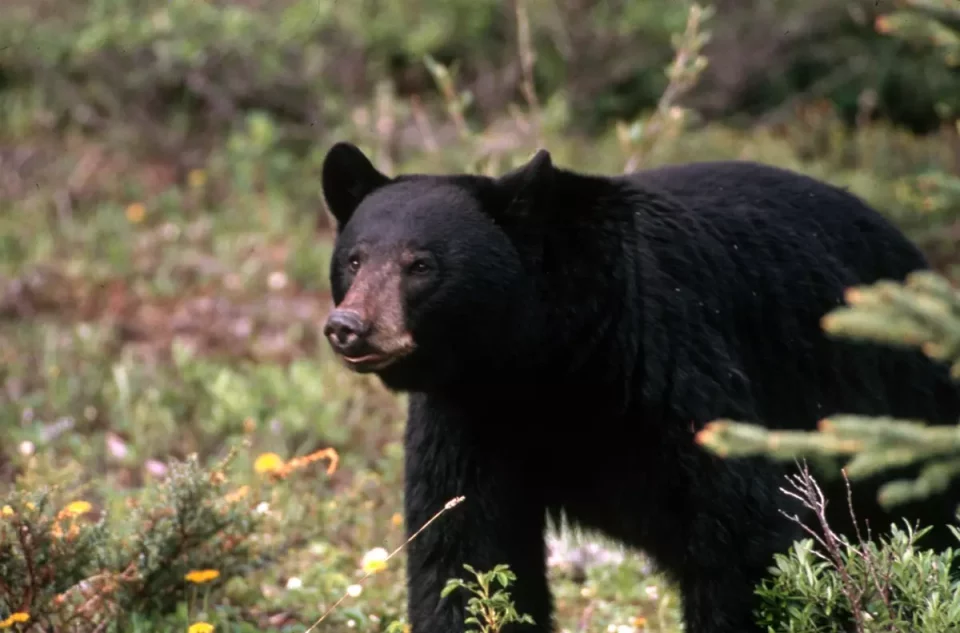Re-posted from 2019

American black bear, U.S. Forest Service, Public Domain
https://www.fws.gov/banner/american-black-bear-adult-usfsjpg
“How common are bears around here?”
“Any recent bear sightings?”
On a daily basis, I get maybe half a dozen variations of these questions, whether it’s at the desk at the Redfish Lake Visitor Center or over the phone at the Ranger Station. Frequently on hikes, I’ll hear the ringing of a bear bell attached to a hiker’s backpack, and I’ve even seen a woman clutching a can of bear spray for the entire duration of the trail.
Is having a bear bell on your pack or bear spray in your hand wrong? Of course not; it is extremely important to be prepared for the worst-case scenario and to be a safe and responsible hiker and camper while exploring the wilderness that is also shared by Idaho’s black bears. This means not only being prepared for the worst-case scenario, but also not giving a bear any reason to be attracted to your home or campsite.
Black bears (Ursus americanus) maintain a healthy population in the wildlands of Idaho. Between 20,000 and 30,000 black bears call Idaho home, and this population is expected to grow by over 15% in the next 10 years (Idaho Fish and Game). With bear populations increasing, how can humans and bears live together and avoid encounters with one another?

Creative Commons License – Gillfoto – Cinnamon – Black Bear Cub tackles Garbage
Bears are naturally curious animals that follow their noses to locate food. Despite popular belief, a black bear’s diet is over 90% berries, nuts, plants, and other vegetation (Idaho Fish and Game). Bears can smell food from over 5 miles away, and often they find themselves in residential areas close to people on their search for high-calorie foods. Bears are attracted to pet food, bird seed, trash, and other things that are commonly found outside houses, in neighborhoods, or even by campgrounds. Because bears find themselves taking advantage of food sources close to people, they have become less weary of people over time. Some bears have become too comfortable around people, and in rare cases when bears show threatening behavior (such as stalking or jaw-clacking), they can’t be relocated responsibly, in which case Idaho Fish and Game is often forced to euthanize these bears when they get too close.
When bears aren’t hibernating, they’re searching for food sources to fatten up for their next hibernation. Since a bear’s diet is mostly low-calorie vegetation, they won’t pass up an opportunity to eat birdseed, dog food, or leftover pizza that they find in a dumpster. Foods such as these that bears find readily in neighborhoods are much more calorie-dense than any plants or berries they find in the forests, and easier to access than searching through berry bushes.
It’s important to prevent this cycle from beginning in the first place so that bears aren’t attracted to your campsite, neighborhood, or home and don’t have a reason to return to the area. Bears have been known to travel 30 miles to return to an accessible food source. If you’re currently living in bear country, what can you do to prevent bears from getting too close?
Creative Commons License – The Angels 2010 – Bear proof trash container

While camping in the developed and dispersed campsites in the front country you are required to securing your food in a bear-proof container or hard-sided vehicle. In the backcountry a bear hang, Ursack, or bear canister are suggested best practices. Along with this, ensure that the containers are properly closed to reduce smells.
If your home is in bear country, don’t leave your trash outside overnight. A bear’s sensitive nose will be able to smell it from many miles away, and a plastic trash bag is no match for a black bear.
Bears are leaving hibernation around March and re-entering typically in November or December. From April-November keep bird feeders out of your yard. Additionally, if you have fruiting trees in your yard, clean up any fallen fruit and pick fruit immediately when you see it is ripening.
As a year-round rule, never leave your pet’s food, coolers, or refrigerators outside, and make sure your barbecue grill is cleaned after every use.
Although Idaho is home to many black bears, taking just a few precautions can greatly reduce your chance of running into one while you’re visiting the Sawtooths, or anywhere in Idaho. If you’re living in or visiting any mountain town in the West, use these precautionary measures to your advantage so you don’t attract any large, furry, guests into your space.
Written by Rachael Marczak, 2019 Naturalist
References & Resources for Further Reading:
https://idfg.idaho.gov/blog/2019/05/living-black-bears
https://www.fs.usda.gov/Internet/FSE_DOCUMENTS/fseprd1017960.pdf
https://www.fs.usda.gov/detailfull/sawtooth/home/?cid=fseprd734582
https://idfg.idaho.gov/sites/default/files/wildlife-express-march-bears-0320.pdf